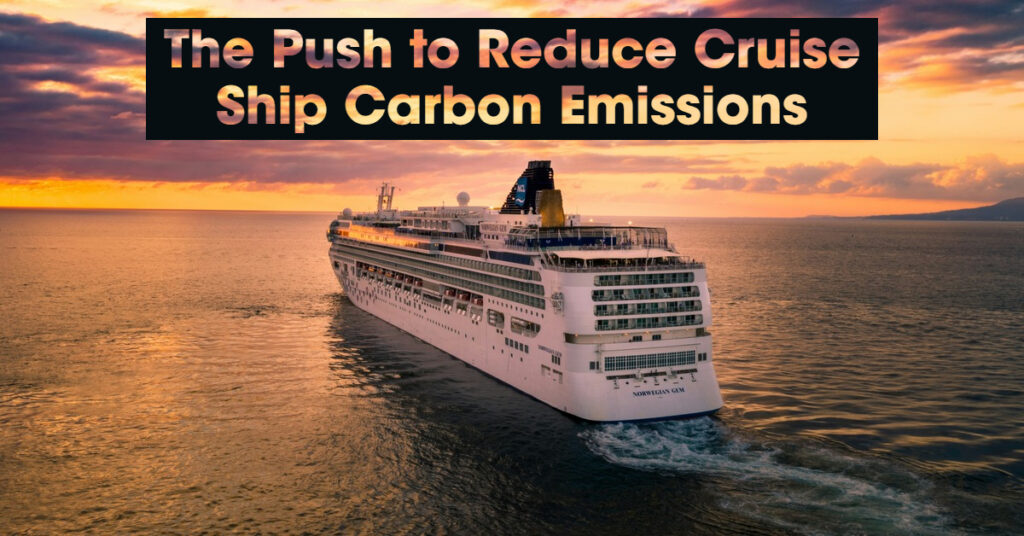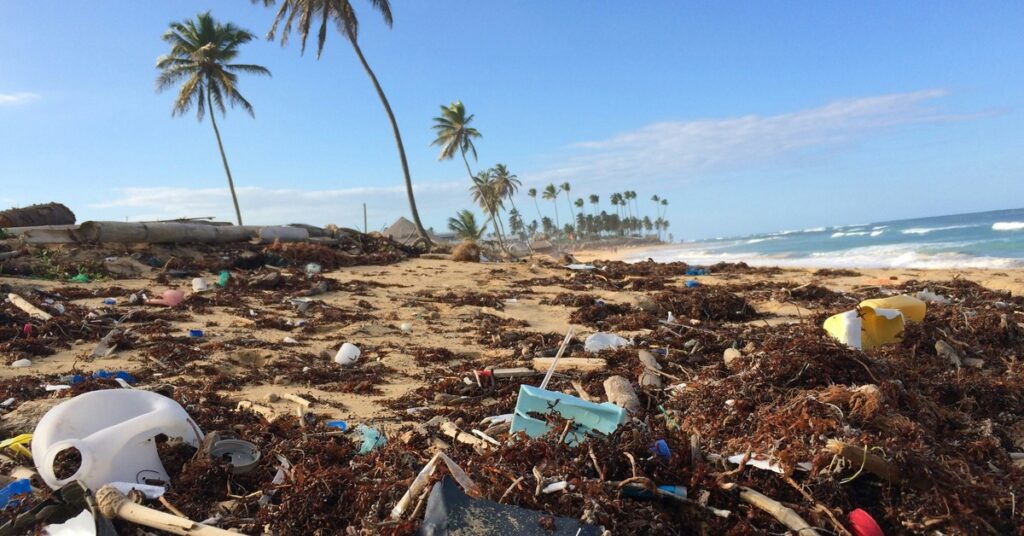In 2024, the cruise industry finds itself at a pivotal crossroads as the global push to combat climate change surges. Cruise ships, known for their luxurious amenities and sprawling itineraries, also carry a major environmental burden, primarily due to their substantial carbon emissions. With increasing regulatory requirements and a growing demand from environmentally conscious travelers, the industry is under immense pressure to innovate and reduce its carbon footprint.

The Environmental Impact of Cruise Ship Emissions
In 2022, almost 5 million people went on a cruise, indicating that the industry is booming post-COVID. This popular mode of leisure travel has significant environmental impacts that raise concerns among environmentalists and policymakers. One major issue is air pollution.
These massive vessels burn heavy fuel oil, a type of marine fuel that emits large quantities of sulfur oxides (SOx), nitrogen oxides (NOx) and particulate matter. These emissions contribute to acid rain, respiratory effects in humans and the formation of ground-level ozone, which is harmful to humans and the environment.
Despite regulations like the International Maritime Organization’s (IMO) 2020 sulfur cap, the transition to cleaner fuels and technologies has been slow and costly, often met with resistance from the industry.
Cruise ship emissions are disproportionately high compared to other forms of transportation, such as cars or airplanes, due to their size and the energy required to power their extensive amenities. For instance, a large cruise ship can emit as much CO2 as thousands of cars over the same period.
These carbon emissions have a compounded effect on the environment. Unlike land-based vehicles, which can use cleaner fuels or electric power, the maritime industry has been much slower in adopting low-carbon technologies. This reliance on fossil fuels contributes to the accumulation of greenhouse gases in the atmosphere, exacerbating global warming and climate change. Despite efforts to introduce more efficient engines and alternative fuels, the cruise industry’s transition to greener technologies has been gradual, partly due to the high costs and logistical challenges.
Furthermore, the impact of cruise ship emissions isn’t limited to the atmosphere — it also affects oceanic and coastal environments. The increased CO2 levels contribute to ocean acidification, which harms marine life, particularly organisms like coral reefs and shellfish. As these ecosystems suffer, the broader marine biodiversity is impacted, leading to disruptions in oceanic food chains and potentially altering local climates.
Regulations and Targets for Emission Reduction
Efforts to regulate and reduce emissions from passenger ships have intensified in recent years, driven by this growing awareness of their environmental impact. The IMO introduced the MARPOL Annex VI regulations to limit air pollutants from ships. A landmark regulation by the EMO is the 2020 sulfur cap, which limits the sulfur content in marine fuel to 0.5%, down from the previous 3.5%.
This change significantly reduces sulfur oxide emissions, though it doesn’t directly address the devastating CO2 emissions. To combat CO2 emissions specifically, the IMO has set an ambitious target to reduce the carbon intensity of internal shipping by no less than 40% by 2030, compared to 2008 levels, and aims for a 70% reduction by 2040.
In addition to internal regulations, several regions have implemented stricter local controls. For instance, the European Union has established Sulfur Emission Control Areas (SECAs) in the Baltic and North Seas, where even stricter limits apply. The United States and Canada have similar regulations in their Emission Control Areas (ECAs) along their coastline.
These areas enforce SOx limits and more stringent controls on nitrogen oxides and particulate matter. Some ports have begun to offer shore power connections, allowing ships to plug into local electricity grids while docked, significantly reducing emissions from idling engines.

Technological Innovations for Emission Reduction
The cruise industry invests in technological innovations to reduce emissions and meet regulatory standards. One of the most significant advances is adopting liquefied natural gas (LNG) as a cleaner alternative to traditional marine fuels.
LNG produces substantially lower SOx, NOx and particulate matter emissions, as well as reduced CO2 emissions. LNG-powered ships are becoming more common, with several new vessels launching with this technology. The largest LNG-powered vessel set sail from Miami earlier this year but raised concerns about its methane emissions, which are also harmful to the planet.
In addition to LNG, dual-fuel engines that can switch between LNG and conventional fuel are being developed to provide greater flexibility and efficiency in fuel use. Dual-fuel systems like Dynamic Gas Blending can significantly reduce maritime emissions while generating savings from fuel efficiency.
Another important technological innovation is the development of exhaust gas cleaning systems, commonly known as scrubbers. These systems remove sulfur and particulate matter from exhaust gases before releasing them into the atmosphere.
There are two main types of scrubbers — open-loop systems that use seawater to neutralize SOx and closed-loop systems that use fresh water treated with alkaline substances. Depending on environmental regulations and conditions, some ships have hybrid scrubbers that can switch between the two modes. Scrubbers are an effective way to reduce air pollution and are being retrofitted on many existing vessels. Unfortunately, these substances don’t just disappear — instead of being released into the air, they’re released into the ocean, harming marine life.
Lastly, energy-efficient technologies are crucial for reducing emissions. Air lubrication systems, which create a layer of micro-bubbles along the hull to reduce friction, can significantly lower fuel consumption. Waste heat recovery systems capture excess heat from the ship’s engines and repurpose it for energy generation, reducing the overall energy demand.
Renewable energy integration, such as solar panels and wind-assisted propulsion, is being explored to supplement conventional power systems. The future of marine propulsion systems, including electric, hybrid, and wind-assisted technologies, is playing a crucial role in making ships more sustainable.
Hybrid propulsion systems that combine traditional engines with battery power are also being developed, allowing ships to operate on electric power for shorter distances or in port areas. These developments collectively make cruise ships more environmentally friendly and align the industry with global sustainability goals.
Challenges and Barriers to Emission Reduction
Reducing maritime emissions in the cruise industry presents several significant challenges, primarily due to the high costs and complexity of transitioning to cleaner technologies. Retrofitting existing ships with advanced emission-reducing technologies such as LNG engines, scrubbers and hybrid propulsion systems requires substantial financial investment.
These upgrades are expensive, time-consuming and technically challenging, often necessitating lengthy dry-dock periods during which ships can’t operate. For many cruise lines, especially smaller operators with limited budgets, these financial and logistical hurdles can be prohibitive, slowing the overall pace of industry-wide adoption.
Another barrier is the availability of infrastructure for alternative fuels. While LNG is a promising cleaner fuel option, its supply and distribution infrastructure is still underdeveloped in many parts of the world. Ports need to invest in LNG bunkering facilities, and cruise lines must ensure their ships can regularly access these ports.
Additionally, LNG’s storage requirements are more complex than those of traditional fuels, requiring specially designed tanks and safety systems. Developing other alternative fuels, such as hydrogen or biofuels, faces similar infrastructure and technological challenges, limiting their immediate feasibility as widespread solutions for reducing cruise ship carbon emissions.
Regulatory and policy uncertainties also pose a significant challenge. While international and regional regulations are stringent, there’s often a lack of uniformity and consistency in their implementation and enforcement. Cruise lines operating globally must navigate a complex web of differing regulations, which can complicate compliance efforts.
Developing and implementing new regulations is slow, leading to uncertainty about future requirements and the long-term viability of certain technologies of investments. This uncertainty can deter investment in new technologies and slow progress toward achieving significant carbon emission reductions.
Striving Toward a Greener Industry
The journey to reduce carbon emissions in the cruise industry is fraught with challenges but is essential for the sector’s long-term viability and environmental responsibility. Technological innovations offer promising avenues for reducing maritime emissions. However, financial constraints, infrastructure limitations and regulatory uncertainties pose significant barriers to rapid progress.
Frequently Asked Questions
How are cruise ships becoming more environmentally friendly?
Cruise ships are becoming more environmentally friendly by adopting cleaner fuel alternatives like liquefied natural gas (LNG) and installing advanced exhaust gas cleaning systems — or scrubbers — to reduce emissions. Additionally, they’re implementing energy efficiency technologies, such as air lubrication systems and waste heat recovery, and exploring renewable energy sources like solar panels and wind-assisted propulsion.
What are the negative impacts of the cruise industry?
The cruise industry negatively impacts the environment through significant carbon emissions, contributing to climate change and air pollution. It generates substantial water pollution from waste discharge and causes physical damage to marine ecosystems. Cruise ship littering also causes a large amount of pollution in the oceans.
How can we reduce cruise ship emissions?
We can reduce cruise ship emissions by transitioning to cleaner fuels like LNG and implementing advanced technologies such as scrubbers and hybrid propulsion systems. Additionally, enhancing energy efficiency through developments like air lubrication systems and integrating renewable energy sources can further minimize cruise ships’ environmental impact.
Are cruises more sustainable than flying?
Cruises are generally less sustainable than flying, as they produce higher carbon emissions per passenger mile due to their extensive energy requirements for operating large ships. Additionally, cruises significantly impact marine ecosystems through waste discharge and physical disturbances, which aren’t as prevalent in air travel.
Are any cruise ships eco-friendly?
While no cruise ships are entirely eco-friendly, some are making notable strides toward sustainability by using cleaner fuels and implementing energy-efficient technologies. These measures reduce their environmental impact, but the industry still faces substantial challenges in achieving full sustainability.
- The 15 Most Exciting New Ships of 2025 – January 6, 2025
- How Old Do You Have to Be to Drive a Boat? – November 12, 2024
- The Engineering Behind Ice-Class Vessels – September 20, 2024



